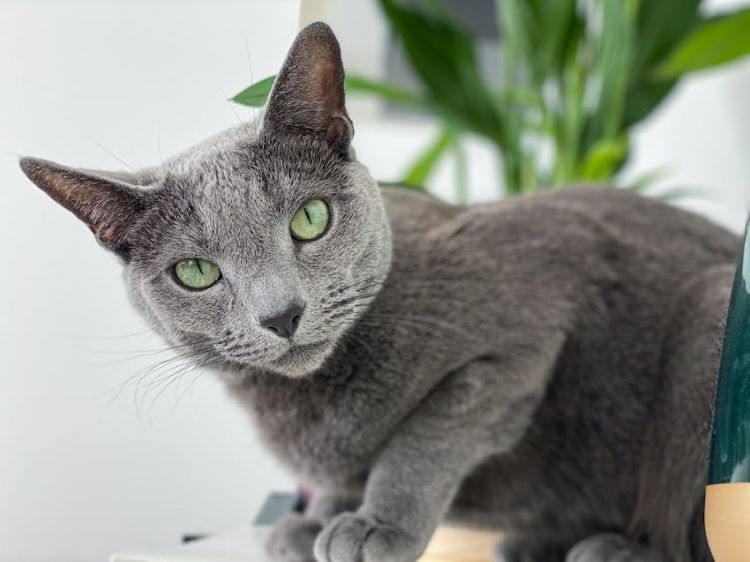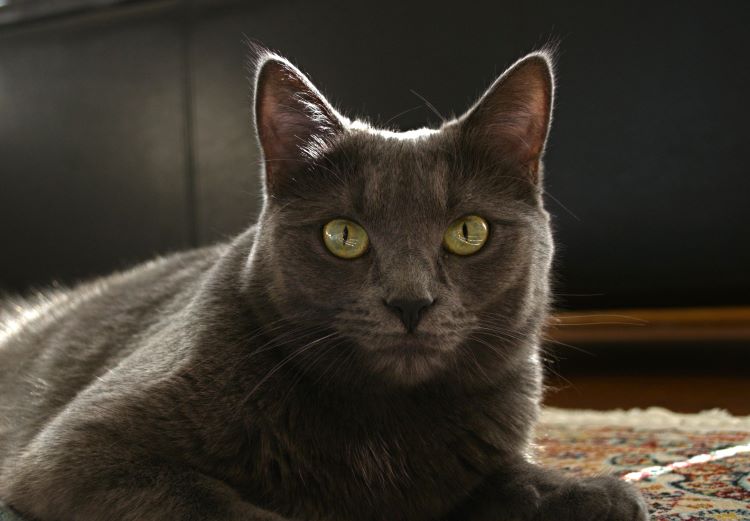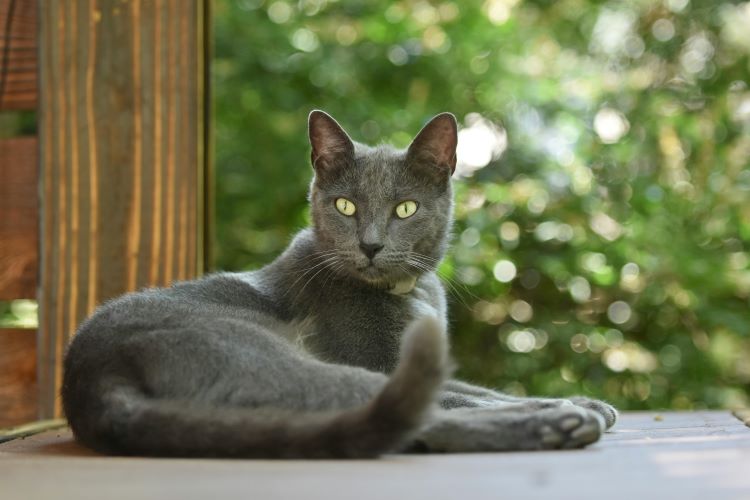Ready to help treat your pet to a healthy life?
Russian Blue Cat Breed: History, Care Tips & Health
By : Trupanion Staff | Published Mar 25, 2025

If you’ve ever been in the presence of a Russian Blue cat, you know why this gorgeous feline breed is partially named after its coat. But did you know that they’re also among the most popular and expensive cat breeds? It may also come as a surprise to learn that not every gray cat that looks like a Russian Blue is actually of the breed. So, what are Russian Blue cats exactly, and what should all prospective pet owners know about their temperaments and health risks?
At Trupanion’s Pet Parenting, we’ve got your back with this in-depth guide to the Russian Blue cat and what makes them so unique.
A Russian Blue or just a gray cat?
There are multiple other cat breeds — the American Shorthair, British Shorthair and Devon Rex, for instance — that can also come with solid gray coats. So, how do you tell if your cat is a Russian Blue or just a gray cat of another breed? The differences may appear subtle to the untrained eye, but there are some key indicators to look for.
According to breed standards from the Cat Fanciers’ Association (CFA) and The International Cat Association (TICA), what sets Russian Blues apart from other gray cats are the following characteristics:
- A short, plush coat that looks gray-blue (typically just called “blue”) and is tipped with silver
- Green eyes that can vary in intensity
- Slightly wedge-shaped head that’s medium in size (not too short, not too long)
- High cheekbones with a straight, non-exaggerated nose
- Wide-set eyes and ears
- Long, elegant legs with small, slightly rounded paws
If your gray kitty has any differing features, they are likely of mixed ancestry or of non-Russian Blue ancestry entirely. And that’s okay! Cat breeds come in so many variations, and that’s part of why we love them.
8 fun facts about Russian Blues
Some more fun details that set these cats apart from their feline brethren:
- It may be no surprise that this breed is believed to have originated in Russia. However, this is unconfirmed, and their exact origins remain a mystery.
- They are a naturally-occurring breed, which means they developed on their own over time without human intervention.
- While no cat is truly hypoallergenic, Russian Blues are known for being allergy-friendly. This is because they are low-shed, may secrete less allergen protein, and their dense coats help keep allergens at bay.
- They are known for their ability to get along with other pets, including dogs. However, early socialization in kittenhood and proper introductions are a must.
- The “Pop Tart Cat” or Nyan Cat meme — often considered one of the most enduring memes of all time — was both inspired and designed after a real-life Russian Blue cat.
- Though known for being independent, these cats also tend to form strong bonds with their owners. They will often spend their days following their humans from room to room.
- Russian Blues are one of the most popular cat breeds, ranking in the top 10 for ownership in North America.
- Though an established breed of their own, they have also been used to help add genetic diversity into other cat breeds like the Nebelung, Havana Brown, and Oriental Shorthair.

History: where do Russian Blue cats come from?
As mentioned in our fun facts, these beautiful gray kitties are often said to be from Russia. In fact, they are rumored to have been the favored pets of Russian Czars and nobility. But while this belief is prevalent, it may not be the truth. Like many cat breeds, the Russian Blue’s exact origins are unknown.
Adding to further confusion, the first-ever recorded appearance of these cats at a show was in 1872, at The Crystal Palace in England, under the breed name “Archangel Cat.” This is because some believe Russian Blues originated in Russia’s port of Afkhangelsk and then joined sailors there on trips around the world. Nevertheless, the “father of cat fancy” Harrison Weir later wrote that these early “Archangel Cats” were not actually Russian Blues as we know them today.
Here’s what Weir specifically wrote in his 1889 book, Our Cats and All About Them:
“This [Russian Blue cat] is shown often under a number of names. It was at first shown as the Archangel cat, then Russian blue, Spanish blue, Chartreuse blue, and, lastly, and I know not why, the American blue. It is not, in my belief, a distinct breed, but merely a light-coloured form of the black cat.”
Despite its murky early origins, the breed as we know today was firmly established after World War II, primarily in England and Scandinavia. By the 1970s, it was found all over the world. It was at this time that breeders in the UK and Australia began developing variations: the Russian Black and the Russian White. However, neither these nor any other variation of the Russian Blue is officially recognized by the CFA or similar organizations.
Temperament and energy needs
All cats have unique personalities, but temperament refers to the natural dispositions that come with each cat breed. If you don’t have a Russian Blue and are currently considering one, it’s important to see how their temperament may mesh with your lifestyle.
These cats are known for their gentle and affectionate temperaments. While many like their alone time, they tend to form strong bonds with their favorite humans, often spending hours following them around. While Russian Blues can be shy around strangers, they tend to be deeply loyal to their families once bonded. They are also known for their quiet nature, often communicating with soft meows.
Along with these friendly traits, Russian Blues are well-regarded for their intelligence. They require daily mental stimulation as a result, which helps prevent them becoming restless. These cats enjoy interactive play, puzzle toys, and even learning new tricks!
How much exercise do Russian Blues need?
Like all cats, Russian Blues need daily exercise to stay healthy. Their needs are not particularly different from most other feline breeds, requiring a minimum of 20 to 30 minutes of active play (exercise) a day. This can be spaced out in short bursts throughout the day.
Activities to help encourage exercise in Russian Blue cats include wands and other teaser toys, laser toys, and bouncy balls. And since so many Russian Blues enjoy following their favorite humans around, you may want to go for longer walks around the home to ensure they’re stretching their legs. You can also try getting a cat tree for climbing (and snoozing, of course).

Breed health concerns
Overall, Russian Blues are considered a healthy cat breed with a good amount of genetic diversity (thanks to their long history and prevalence, despite origins unknown). Still, all breeds are predisposed to certain health risks.
Common health conditions to be aware of in these cats include (but may not be limited to) the following:
- Obesity — These kitties can be more likely to gain weight, especially if they don’t get sufficient daily exercise. This can lead to other health issues like diabetes and joint problems.
- Diabetes — More common in overweight Russian Blues, diabetes requires careful management with diet and possibly insulin.
- Bladder Stones (Urolithiasis) — They may be prone to urinary tract issues, including the formation of bladder stones.
- Hypertrophic Cardiomyopathy (HCM) — A genetic heart disease that affects some cats, though it is less common in Russian Blues compared to other breeds.
- Periodontal Disease — Like many cats, they can develop gum disease and tooth decay if proper dental care isn’t maintained.
- Allergies — Some Russian Blues may develop allergies to certain foods, environmental factors, or fleas.
- Respiratory Infections — Though not breed-specific, they can be susceptible to upper respiratory infections, especially as kittens.
- Polycystic Kidney Disease (PKD) — An illness where cysts form on the kidneys in cats. This is on the rarer side, but can still occur in Russian Blues.
Tips for keeping Russian Blues healthy
Regular veterinary check-ups, a balanced diet, and daily exercise can help manage many of the conditions listed above or prevent them entirely. And, since hygiene can also affect your cat’s health, you’ll want to clean litter boxes daily and stick to a routine grooming schedule. Yes, cats are self-grooming, but even short-haired felines like the Russian Blue need some help from time to time. Get a gentle brush, and use it every one to two weeks.
If you have a Russian Blue, it’s important to talk with their veterinarian about their specific health risks. But since you can’t predict what exactly will affect your pet or when, it’s also a good idea to sign up for cat insurance in case of surprise illnesses or injuries.
Russian Blue cats in pop culture
Russian Blues have certainly made an impression on those who’ve known them, making them a staple of human pop culture. Here’s just a short list of appearances Russian Blues have made in movies, literature, and other media over the years:
- Arlene in 2004’s Garfield: the Movie (a contrast to the comic strip version’s pink cat of unknown breed)
- Catherine from 2010’s Cats & Dogs: the Revenge of Kitty Galore
- Smokey, the main antagonist in the 1999 film, Stuart Little
- Felicity from the book and its 1994 German animated film adaptation, Felidae
- The “Nyan Cat” meme was based on creator Christopher Torres’ real-life Russian Blue pet cat, Marty.
- The Hotel Metropol’s lobby cat in the 2016 novel, A Gentleman in Moscow
